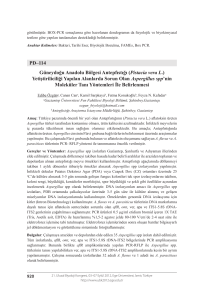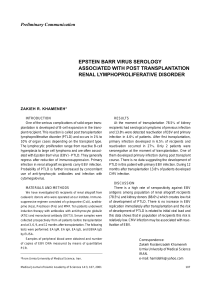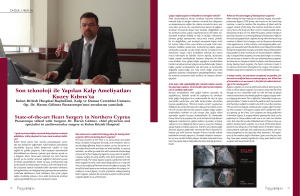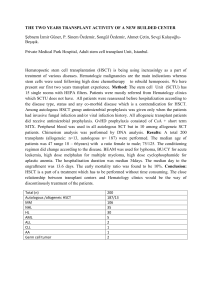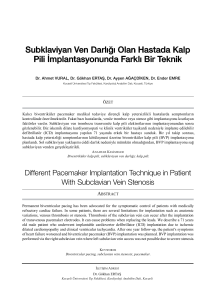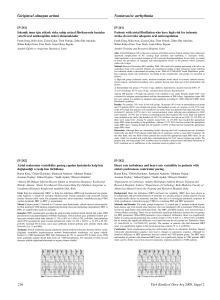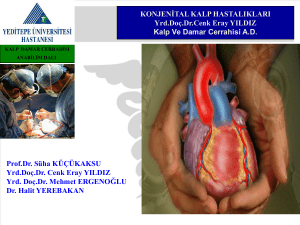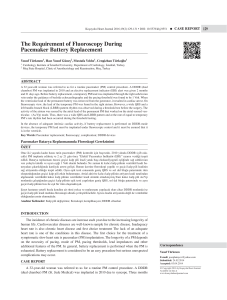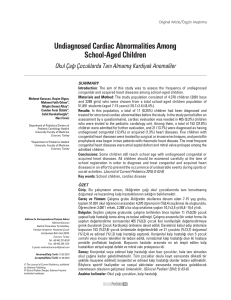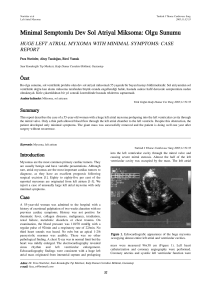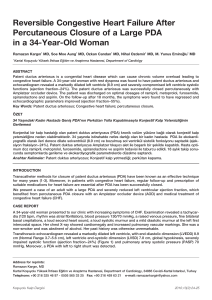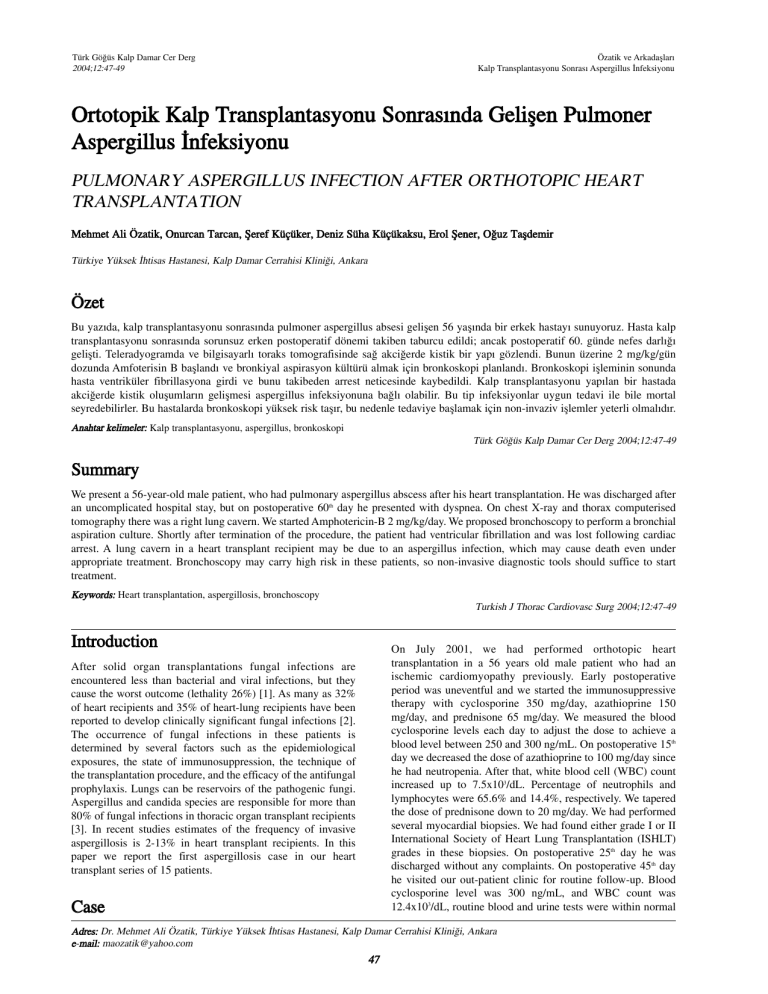
Türk Göðüs Kalp Damar Cer Derg
2004;12:47-49
Özatik ve Arkadaþlarý
Kalp Transplantasyonu Sonrasý Aspergillus Ýnfeksiyonu
Ortotopik Kalp Transplantasyonu Sonrasýnda Geliþen Pulmoner
Aspergillus Ýnfeksiyonu
PULMONARY ASPERGILLUS INFECTION AFTER ORTHOTOPIC HEART
TRANSPLANTATION
Mehmet Ali Özatik, Onurcan Tarcan, Þeref Küçüker, Deniz Süha Küçükaksu, Erol Þener, Oðuz Taþdemir
Türkiye Yüksek Ýhtisas Hastanesi, Kalp Damar Cerrahisi Kliniði, Ankara
Özet
Bu yazýda, kalp transplantasyonu sonrasýnda pulmoner aspergillus absesi geliþen 56 yaþýnda bir erkek hastayý sunuyoruz. Hasta kalp
transplantasyonu sonrasýnda sorunsuz erken postoperatif dönemi takiben taburcu edildi; ancak postoperatif 60. günde nefes darlýðý
geliþti. Teleradyogramda ve bilgisayarlý toraks tomografisinde sað akciðerde kistik bir yapý gözlendi. Bunun üzerine 2 mg/kg/gün
dozunda Amfoterisin B baþlandý ve bronkiyal aspirasyon kültürü almak için bronkoskopi planlandý. Bronkoskopi iþleminin sonunda
hasta ventriküler fibrillasyona girdi ve bunu takibeden arrest neticesinde kaybedildi. Kalp transplantasyonu yapýlan bir hastada
akciðerde kistik oluþumlarýn geliþmesi aspergillus infeksiyonuna baðlý olabilir. Bu tip infeksiyonlar uygun tedavi ile bile mortal
seyredebilirler. Bu hastalarda bronkoskopi yüksek risk taþýr, bu nedenle tedaviye baþlamak için non-invaziv iþlemler yeterli olmalýdýr.
Anahtarr kelimelerr: Kalp transplantasyonu, aspergillus, bronkoskopi
Türk Göðüs Kalp Damar Cer Derg 2004;12:47-49
Summary
We present a 56-year-old male patient, who had pulmonary aspergillus abscess after his heart transplantation. He was discharged after
an uncomplicated hospital stay, but on postoperative 60th day he presented with dyspnea. On chest X-ray and thorax computerised
tomography there was a right lung cavern. We started Amphotericin-B 2 mg/kg/day. We proposed bronchoscopy to perform a bronchial
aspiration culture. Shortly after termination of the procedure, the patient had ventricular fibrillation and was lost following cardiac
arrest. A lung cavern in a heart transplant recipient may be due to an aspergillus infection, which may cause death even under
appropriate treatment. Bronchoscopy may carry high risk in these patients, so non-invasive diagnostic tools should suffice to start
treatment.
Keyyworrds: Heart transplantation, aspergillosis, bronchoscopy
Turkish J Thorac Cardiovasc Surg 2004;12:47-49
Introduction
On July 2001, we had performed orthotopic heart
transplantation in a 56 years old male patient who had an
ischemic cardiomyopathy previously. Early postoperative
period was uneventful and we started the immunosuppressive
therapy with cyclosporine 350 mg/day, azathioprine 150
mg/day, and prednisone 65 mg/day. We measured the blood
cyclosporine levels each day to adjust the dose to achieve a
blood level between 250 and 300 ng/mL. On postoperative 15th
day we decreased the dose of azathioprine to 100 mg/day since
he had neutropenia. After that, white blood cell (WBC) count
increased up to 7.5x103/dL. Percentage of neutrophils and
lymphocytes were 65.6% and 14.4%, respectively. We tapered
the dose of prednisone down to 20 mg/day. We had performed
several myocardial biopsies. We had found either grade I or II
International Society of Heart Lung Transplantation (ISHLT)
grades in these biopsies. On postoperative 25th day he was
discharged without any complaints. On postoperative 45th day
he visited our out-patient clinic for routine follow-up. Blood
cyclosporine level was 300 ng/mL, and WBC count was
12.4x103/dL, routine blood and urine tests were within normal
After solid organ transplantations fungal infections are
encountered less than bacterial and viral infections, but they
cause the worst outcome (lethality 26%) [1]. As many as 32%
of heart recipients and 35% of heart-lung recipients have been
reported to develop clinically significant fungal infections [2].
The occurrence of fungal infections in these patients is
determined by several factors such as the epidemiological
exposures, the state of immunosuppression, the technique of
the transplantation procedure, and the efficacy of the antifungal
prophylaxis. Lungs can be reservoirs of the pathogenic fungi.
Aspergillus and candida species are responsible for more than
80% of fungal infections in thoracic organ transplant recipients
[3]. In recent studies estimates of the frequency of invasive
aspergillosis is 2-13% in heart transplant recipients. In this
paper we report the first aspergillosis case in our heart
transplant series of 15 patients.
Case
Adrres: Dr. Mehmet Ali Özatik, Türkiye Yüksek Ýhtisas Hastanesi, Kalp Damar Cerrahisi Kliniði, Ankara
e-m
mail: [email protected]
47
Özatik et al
Aspergillus Infection After Heart Transplantation
Turkish J Thorac Cardiovasc Surg
2004;12:47-49
Figure 2. Computerised tomography of thorax.
Figure 1. Teleradiogram of the patient.
resuscitation for about an hour, but we lost the patient. On postmortem cytological examination of broncho-alveolar lavage
material we found aspergillus fumigatus (Figure 3).
Discussion
The aspergillus species rarely cause infection in healthy
individuals but pose a great risk for transplant recipients. It is
the most common non-candida fungal infection occurring in
these patients, and the fatality rate for invasive aspergillosis
exceeds 80% [3]. Furthermore not uncommonly, aspergillus
infection can occur concomitantly with candida infection
during the intermediate post-transplant period (22-90 days after
transplantation). Sixty-six percent of fungal infections occur in
the first 3 months after transplantation; this is most likely due
to intensive immunosuppressive regimen in that period [4].
Classically, the major risk factors for invasive pulmonary
aspergillosis (IPA) include severe or prolonged neutropenia
(absolute neutrophil count < 500/dL) and prolonged high-dose
corticosteroid therapy [5]. In the absence of an effective host
immune response, the spores mature into hyphae that can
invade the pulmonary structures, particularly blood vessels.
This results in pulmonary artery thrombosis, haemorrhage,
lung necrosis and systemic dissemination.
In the immunocompromised or neutropenic host, IPA is the
most common manifestation of an aspergillus infection,
although local infections also occur in the sinuses, skin, or
intravenous catheter site. A definite diagnosis of IPA is difficult
to establish because there is no single diagnostic test that is
either universally applicable or sensitive and specific enough.
Some non-invasive tests can support the diagnosis, like
detection of aspergillus antigen in serum and positive
aspergillus culture from an extra-pulmonary site [6]. A
probable diagnosis of IPA is possible for patients with the
characteristic clinical picture of sudden onset of shortness of
breath, pleuritic chest pain, hemoptysis, pulmonary infiltrates
and high-grade fever while on broad-spectrum antibiotics, and
IPA appears on radiographs as multiple ill-defined 1-2 cm
nodules that gradually coalesce into larger masses or areas of
consolidation [7]. An early computed tomography finding is
the rim of ground-glass opacity surrounding the nodules (halo
Figure 3. Microscopic view of the broncho-alveolar lavage
material showing aspergillus fumigatus (Gram stain, X100
magnification).
limits; cultures of throat, urine, blood and sputum did not
reveal any organism. He had no complaints at that time and we
let him go home. On postoperative 60th day he presented with
dyspnea. Respiratory sounds could not be auscultated over
right middle lobe. His physical examination did not reveal any
other pathologic findings. On echocardiographic examination
cardiac functions were within normal limits; left ventricular
ejection fraction was 59%. His body temperature was 38.5°C,
WBC count was 2.7x103/dL, percentage of neutrophils and
lymphocytes were 82.9% and 6.8%, respectively. On
teleradiogram there was an image on right lung looking like a
cavern (Figure 1). We did thorax computerised tomography
(CT), which revealed a 35x35 mm-sized cystic cavitary lesion
at the middle lobe of the right lung (Figure 2). We did sputum
and fine needle aspiration biopsy cultures but could not
cultivate any organism. We started Teicoplanin 3 mg/kg/day,
Amphotericin-B 2 mg/kg/day, and metronidazole 1 g/day; then
we planned bronchoscopy for definitive diagnosis. Under local
anesthesia we performed bronchoscopy, which revealed clear
airways and increased amount of secretions. Shortly after
termination of the procedure, the patient had ventricular
fibrillation and cardiac arrest. We applied cardiopulmonary
48
Türk Göðüs Kalp Damar Cer Derg
2004;12:47-49
Özatik ve Arkadaþlarý
Kalp Transplantasyonu Sonrasý Aspergillus Ýnfeksiyonu
sign) [8]. This sing is non-specific and has also been described
in patients with tuberculosis, mucormycosis and Wegener’s
granulomatosis. Cavitation is usually a late finding. The
intracavitary mass composed of sloughed lung and the
surrounding rim of air may be seen as the “air crescent sing”.
Pleural effusion is unusual and adenopaties are rare. A
definitive diagnosis of IPA was established for patients with
similar clinical presentation by bronchoscopy with bronchoalveolar lavage demonstrating aspergillus organism on
cytological examination and/or on culture or by histology or
culture from surgery or autopsy.
Patients with IPA were treated with intravenous AmphotericinB 1-1.5 mg/kg/day during neutropenia, and with Itraconazole
thereafter until resolution of CT scan lesions, usually for 4-6
moths. The most prominent disadvantage of Amphotericin-B is
its nephrotoxic effect. The treatment of aspergillosis with
Amphotericin-B in solid organ transplant recipients results in a
higher incidence of nephrotoxicity because of concomitant use
of cyclosporine [9]. Liposomal Amphotericin-B has far fewer
side effects and can be much more safely used in patients with
solid organ transplants, despite concomitant use cyclosporine.
In conclusion, aspergillus is an important cause of infection in
heart transplant recipients, especially during early period. It
carries high mortality even under appropriate treatment. For
this reason, this infection should always be kept in mind, and a
suspect of diagnosis from clinical and radiological signs should
let the physician start the treatment immediately. This may help
to prevent deaths due to aspergillus infections in transplant
recipients. Since bronchoscopy carries high risk in these
patients, we do not recommend it anymore.
2.
3.
4.
5.
6.
7.
8.
9.
References
1. Grossi P, De Maria R, Caroli A, Zaina MS, Minoli L.
49
Infection in heart transplant recipients: The experience of
the Italian heart transplantation program. J Heart Lung
Transplant 1992;11:847-66.
Paya CV. Fungal infections in solid-organ transplantation.
Clin Infect Dis 1993;16;677-88.
Dummer JS, Montero CG, Griftith BP, Hardesty RL,
Paradis IL, Ho M. Infections in heart-lung transplant
recipients. Transplantation 1986;41:725-9.
Hofflin JM, Potasman I, Baldwin JC, Oyer PE, Stinson EB,
Remington JS. Infectious complications in heart transplant
recipients receiving cyclosporine and corticosteroids. Ann
Intern Med 1987;106:209-16.
Denning DW. Diagnosis and management of invasive
aspergillosis. Curr Clin Top Infect Dis 1996;16:277-99.
Patterson TF, Minter P, Patterson JE, Rappeport JM,
Andriole VT. Aspergillus antigen detection in the diagnosis
of invasive aspergillosis. J Infect Dis 1995;171:1553-8.
Klein DL, Gamsu G. Thoracic manifestations of
aspergillosis. Am J Roentgenol 1980;134:543-52.
Kuhlman JE, Fishman EK, Siegelman SS. Invasive
pulmonary aspergillosis and acute leukemia: Characteristic
findings on CT, the CT halo sign, and the role of CT in
early diagnosis. Radiology 1985;157:611-4.
Harari S. Current strategies in the treatment of invasive
aspergillus infections in immunocompromised patients.
Drugs 1999;58:621-31.

